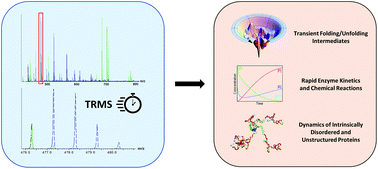Unravelling the mysteries of sub-second biochemical processes using time-resolved mass spectrometry
Abstract
Many important chemical and biochemical phenomena proceed on sub-second time scales before entering equilibrium. In this mini-review, we explore the history and recent advancements of time-resolved mass spectrometry (TRMS) for the characterization of millisecond time-scale chemical reactions and biochemical processes. TRMS allows for the simultaneous tracking of multiple reactants, intermediates and products with no chromophoric species required, high sensitivity and temporal resolution. The method has most recently been used for the characterization of several short-lived reaction intermediates in rapid chemical reactions. Most of the reactions that occur in living organisms are accelerated by enzymes, with pre-steady state kinetics only attainable using time-resolved methods. TRMS has been increasingly used to monitor the conversion of substrates to products and the resulting changes to the enzyme during catalytic turnover. Early events in protein folding systems have also been elucidated, along with the characterization of dynamics and transient secondary structures in intrinsically disordered proteins. In this review, we will highlight representative examples where TRMS has been applied to study these phenomena.

- This article is part of the themed collection: CSC100: Celebrating Canadian Chemistry


 Please wait while we load your content...
Please wait while we load your content...